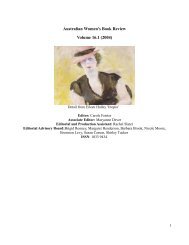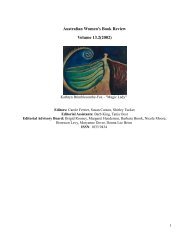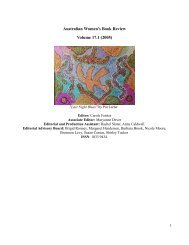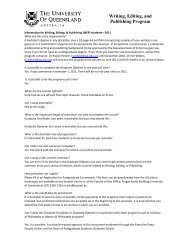Australian Women's Book Review Volume 14.1 - School of English ...
Australian Women's Book Review Volume 14.1 - School of English ...
Australian Women's Book Review Volume 14.1 - School of English ...
You also want an ePaper? Increase the reach of your titles
YUMPU automatically turns print PDFs into web optimized ePapers that Google loves.
at once moving and horrifying.<br />
These difficulties also surface in relation to the question <strong>of</strong> eroticism. McDonald argues, again, that art<br />
is 'always erotic' - particularly when it has to do with representations <strong>of</strong> the body. But is this really the<br />
case? Does art have to be erotic to be 'good'? Don't artists and audiences engage in a kind <strong>of</strong> perennial<br />
dispute over what is erotic in art and what isn't? Because the logic that operates here is one in which<br />
increasingly diverse ways <strong>of</strong> envisioning the female body - inevitably erotic, inevitably ambiguous -<br />
come to be included within a feminised ideal, the risk McDonald's book runs is that <strong>of</strong> ending up with<br />
an innocuous, EEO-style view <strong>of</strong> erotic ambiguity in art. Reading McDonald's account, we might get<br />
the sense that, while there is not much we would want to disagree with in it, things would get more<br />
interesting if there were.<br />
This said, the pluralist approach McDonald adopts enables her to put forward a welcome reassessment<br />
<strong>of</strong> the state <strong>of</strong> play between contemporary art and recent debates in feminism. Her book brings together<br />
many valuable insights into the work <strong>of</strong> artists as different as Patricia Piccinini, Fiona Foley, Zoe<br />
Leonard and Pat Brassington, as well as <strong>of</strong>fering thought-provoking reflections on a range <strong>of</strong> topics -<br />
from pornography and the eroticisation <strong>of</strong> children in advertising, to multiculturalism, queer theory and<br />
'bad girl' postfeminism. Most interestingly, perhaps, her book develops an analytical framework in<br />
which recent developments in art practice, inside and outside Australia, can be considered in terms <strong>of</strong><br />
current feminist concerns.<br />
In broad terms, McDonald outlines a dialectical movement taking place in the last few decades in art.<br />
In the 1970s, artists like Carolee Schneemann and Judy Chicago scandalised many observers by<br />
contesting traditional representations <strong>of</strong> the female body with their use <strong>of</strong> vaginal imagery and highly<br />
sexualised performances. As McDonald points out, their art was not meant simply to shock, but also to<br />
propose other ways <strong>of</strong> figuring femininity in art and, more specifically, to reconnect artistic<br />
representations <strong>of</strong> the female body to lived experience. If the strategies adopted by these artists were<br />
soon seen as naïve and limiting for their apparent consignment <strong>of</strong> female experience to the realm <strong>of</strong><br />
nature, genital corporeality and 'base' matter, the pendulum was to swing very far the other way in the<br />
1980s, as McDonald observes. She argues that, in this decade, alliances between feminism and<br />
'poststructuralism' (postmodernism, deconstruction and, most importantly, theories <strong>of</strong> the gaze drawing<br />
on psychoanalysis) tend to lose the thread tying feminist art practice to the search for alternative ways<br />
to represent the female body. At this point, McDonald suggests, a preoccupation with poststructuralist<br />
theory leads to artistic strategies that remain 'negative' ins<strong>of</strong>ar as they are locked within a critique <strong>of</strong><br />
dominant modes <strong>of</strong> representation, subjectivity and spectatorship. In McDonald's view, the art that<br />
issues from these alliances remains too rhetorical, too nihilist, and too suspicious <strong>of</strong> representation and<br />
visuality in general, to be very 'positive' in its effects. All it can finally do is say, like Barbara Kruger in<br />
a famous work from 1981: 'Your gaze hits the side <strong>of</strong> my face.'<br />
According to McDonald, however, by the end <strong>of</strong> the 1980s there is something like a 'return <strong>of</strong> the real'<br />
in art (to use Hal Foster's term) - and with it, a return to a real engagement with the representation <strong>of</strong><br />
the female body in artistic practice. McDonald argues that a more productive 'revisioning' <strong>of</strong> the<br />
representation <strong>of</strong> the female body arises from contacts between feminism (or 'postfeminism') and wider<br />
social and political concerns, along with the influence <strong>of</strong> 'post-poststructuralist' theories - it arises, for<br />
example, from theories <strong>of</strong> performativity, postcoloniality, queer theory and recent debates on the effects<br />
<strong>of</strong> new technologies. Thus a more complex, 'embodied' and multifaceted conception <strong>of</strong> the female body<br />
is seen to emerge in the work <strong>of</strong> artists like Zoe Leonard, Della Grace, Destiny Deacon and Patricia<br />
31








